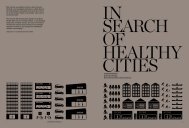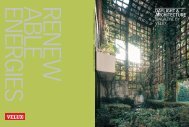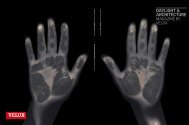Download as PDF - Daylight & Architecture - Magazine by | VELUX
Download as PDF - Daylight & Architecture - Magazine by | VELUX
Download as PDF - Daylight & Architecture - Magazine by | VELUX
You also want an ePaper? Increase the reach of your titles
YUMPU automatically turns print PDFs into web optimized ePapers that Google loves.
Modern architecture h<strong>as</strong> meansof bringing daylight to almostanywhere in buildings. Thesemeans, however, are not alwaysused in such a m<strong>as</strong>terly manner<strong>as</strong> in this building <strong>by</strong> Louis Kahn.“Light is matter and light is b<strong>as</strong>icmaterial. Once you understandhow light varies, and varies ourperceptions, your architecturalvocabulary is immediately extended,in ways that cl<strong>as</strong>sicalarchitecture never thought of …an architecture of ephemeralitybecomes possible.”Jean Nouveland h<strong>as</strong> continued to condition our preferencefor natural daylight over artificiallight, irrespective of subsequent scientificinnovations, greater lamp efficiency andsupplementary lighting systems.CONSTRUCTING WITH LIGHTAs human civilisation h<strong>as</strong> expanded fromindividually dispersed buildings to thedense mega-cities of today, the challengeand demand for daylight h<strong>as</strong> becomemore and more competitive. This is trendis likely to gain greater significance <strong>as</strong>, <strong>by</strong>2020, 70% of the world’s population willlive in urbanised communities. We havebecome perpetual urban ‘cave’ dwellers,becoming incre<strong>as</strong>ingly remote from the‘naturalness’ of daylight (its sequencing,rhythm and rituals) and experiencing aloss in physical and emotional benefits.In part, we have successfully adaptedto this reduction and loss in daylight, <strong>by</strong>evolving new patterns of living and reconditioningour immediate environments.We have compensated throughplanning legislation (for example <strong>by</strong> restrictingbuilding heights, legislating forrights to light, and stipulating setbacks onelevations of high-rise buildings), <strong>by</strong> constructingmore of our buildings with gl<strong>as</strong>selevations and supplementing their interiorswith the use of artificial light sourcesand atria. Yet despite these me<strong>as</strong>ures, weconsistently yearn for a return to naturaldaylight, and we have not lost the desirefor daylight to support our fundamentalactivities. In addition, it is becomingincre<strong>as</strong>ingly evident that however wellcontrolled, uniformly lit and efficientartificially illuminated environmentsbecome, they lack the psychological andbiological provisions we need and fail togenerate the desired sense of well-being 2 .We desire light not only for illuminationbut also for the stimulation that can onlybe provided <strong>by</strong> the sun and daylight.Natural light changes and incre<strong>as</strong>esin intensity throughout the day, and isaltered in effect <strong>by</strong> climate conditions likecloud cover and sunshine hours. Artificiallight, on the other hand, is not diverse incolour and lacks many of the phenomenologicalqualities that are characteristic ofnatural light effects, due to geographicalfeatures and proximity to water. (Considerthe typical characteristics of the soft,hazy light in Venice, for example). Thelight artist James Turrell h<strong>as</strong> describedthese phenomena <strong>as</strong> “the area of spatialand optical tension” – the experience ofthe awareness of light that is more thanmerely a source of brightness. 3Given our natural need for daylight,the lack of daylight in our everyday livesh<strong>as</strong> led to an incre<strong>as</strong>ing range of healtheffects and unfavourable psychologicalconditions. Human behaviour is modulated<strong>by</strong> the day/night cycle that we candirectly observe through the level of ambientlight. It is also a fact that our contemporarylives are ruled <strong>by</strong> time and thoughwe use clocks to moderate our actions, ourhuman biology is paced <strong>by</strong> our ‘circadianclock’, which determines sleep patterns,alertness, mood, blood pressure and thealignment of our experience and metabolismto night and day. Setting our bodyclock to local time is adjusted on a dailyb<strong>as</strong>is <strong>by</strong> exposure to light, and a failure toengage results in a drift or ‘free running’circadian rhythms, and a disruption inthese cycles. 4Disturbances of this cycle can lead toa range of behavioural anomalies such<strong>as</strong> sleep, eating and mood disorders, andin the winter months this can lead to depression.This range of effects suggeststhat a specific light/dark cycle exists forhumans, including temporal and spectralproperties, that optimise and contributeto well-being.The current mode of living is stronglydependent on the use of artificial light andh<strong>as</strong> tended to isolate us from nature anddaylight to a large extent, particularly incities. There is therefore a contradictionbetween our lifestyle and the ambientcues we need to maintain a balance inour health and sense of well-being.LIGHTNESS OF BEINGThe scientific findings and everyday observationsdiscussed above provide ampleevidence that there is an innate humanneed for daylight, which cannot be adequatelyfulfilled <strong>by</strong> alternative (artificial)light sources. This raises the question ofhow architecture – and specifically the44 D&A SPRING 2011 Issue 15










